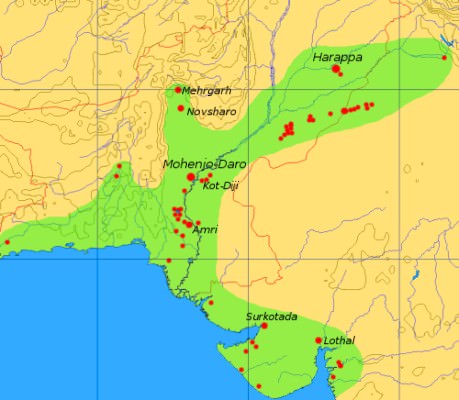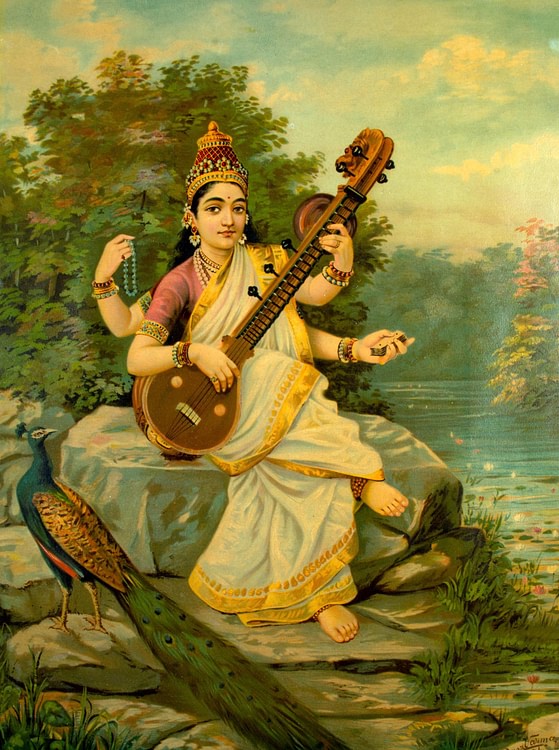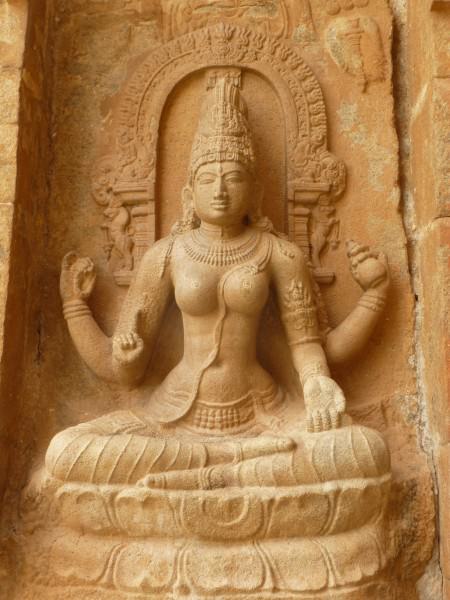Aryan › Saraswati » Ancient origins
Articles and Definitions › Contents
- Aryan › Antique Origins
- Saraswati › Who Was
Ancient civilizations › Historical and archaeological sites
Aryan › Antique Origins
Definition and Origins

The source of the English word Aryan comes from the Sanskrit word ārya, which is the self-designation used by the Vedic Indic people who migrated into the Indian subcontinent around 1500 BCE. The Sanskrit term has a cognate in the Iranian word arya, which is also a self-designation. Both the Sanskrit and the Iranian terms descend from a form ārya that was used by the Indo-Iranian tribes to refer to themselves, a term which is also connected to the source of the country-name Iran, from a phrase meaning Kingdom of the Aryans. The term Aryan has had a history filled with controversy.
ARYAN - A MISUSED TERM
The original meaning of the term is unknown and different meanings have been proposed, the most common being nobleman.During the 19th century CE, it was proposed that this was not only the Indo-Iranian tribal self-designation but also the self-designation used by the ancestors of all Indo-Europeans, which is a theory no longer accepted. Aryan then came to be used as a synonym of Indo-European. Some time later it was further proposed that the ancestors of the Indo-European people had their homeland located in northern Europe, implying that Indo-Europeans were originally of a Nordic racial type. Thus, Aryandeveloped yet another, purely racial meaning, probably one of the most familiar meanings today.
BY 1500 BCE THE ARYANS MIGRATED INTO THE INDIAN SUBCONTINENT, CROSSING THE HINDU KUSHMOUNTAINS.
THE ARYAN MIGRATION
Before the time of the Aryan migration into the Indian subcontinent, there was a highly developed civilization in ancient Indiaknown as the Indus Valley Civilization, which was located in what is Pakistan and northwest India today, on the fertile flood plain of the Indus River and its vicinity. The earliest evidence of religious practices in this area dates back approximately to 5500 BCE, farming settlements began around 4000 BCE, and around 3000 BCE there appeared the first signs of urbanization. By 2600 BCE, dozens of towns and cities had been established and between 2500 and 2000 BCE the Indus Valley Civilization was at its peak. The evidence suggests that the Indus Valley Civilization had social conditions comparable to Sumeria and even superior to the contemporary Babylonians and Egyptians.
By 1500 BCE the Aryans migrated into the Indian subcontinent. Coming from central Asia, this large group of nomadic cattle herders crossed the Hindu Kush Mountains and came in contact with the Indus Valley Civilization. This was a large migration and used to be seen as an invasion, which was believed by some scholars to be behind the collapse of the Indus Valley Civilization; this hypothesis is not unanimously accepted today.

Map of the Indus Valley Civilization
Today scholars have a different understanding of how things developed. We know that a process of decay was already underway in 1800 BCE; some say that the Saraswati River was drying up, others that the region suffered catastrophic floods.The consequences of either event would have had a catastrophic effect on agricultural activity, making the economy no longer sustainable and breaking the civic order of the cities. The evidence supporting the decline of the Indus River Civilization is compelling: Writing started to disappear, standardized weights and measures used for trade and taxation purposes fell out of use, the connection with the Near East were interrupted, and some cities were gradually abandoned.
IN MYTH & LITERATURE
Linguistic studies have shown that as the Aryans migrated into the Indian subcontinent, the Aryan language gained ascendency over the local languages. They also gradually adopted an agricultural lifestyle which was widely established by around 1000 BCE. Despite the fact that we have no historical records of this periods, we have a mythical record in the form of religious literature known as The Vedas, one of the most important religious books in Indian history. Stories about military conflicts and other hostilities are recorded in the Vedas, but the historical reliability of this episodes is uncertain.
Saraswati › Who Was
Definition and Origins

Saraswati (also Sarasvati ) is the Hindu goddess of learning, wisdom, music, and aesthetics. She is also known as Bharati (eloquence), Shatarupa (existence), Vedamata ('mother of the Vedas '), Brahmi, Sarada, Vagisvari, and Putkari. As Vac, she is the goddess of speech. Saraswati first appears in the Rigveda and, in later religious texts, she is identified as the inventor of Sanskrit and, appropriately, gives Ganesha the gifts of pen and inks. She is also a patron of the arts and sciences, and the wife of Brahma, even if the Bengal Vaisnavas considered her first the wife of Vishnu. Sarasvati is also worshipped as the goddess of learning in Jainism and by some Buddhist sects.
WORSHIP & RITUALS
Saraswati's name means 'elegant', 'flowing', and 'watery' and this is indicative of her status as one of the early Aryan boundary rivers. The Saraswati River (modern name: Sarsuti), just like the Ganges River, flows from the Himalaya and is considered a sacred source of purification, fertility, and good fortune for those who bathe in her waters. The sacred river, again like the Ganges, then developed into a personified deity.
THE GODDESS HAS HER OWN FESTIVALS, NOTABLY THE SARASVATI PUJA, HELD ON THE FIRST DAY OF SPRING.
The goddess has her own festivals, notably the Saraswati Puja, held on the first day of spring. During the festival, worshippers wear yellow, which is associated with wisdom and prosperity. Statues of the goddess are also draped in yellow silk, and believers pray for blessings on their pens, books, and musical instruments. Children are taught to write for the first time during the festival, Brahmin priests are given fine food, and ancestors are venerated. Saraswati is also worshipped along with other major goddesses in the pan -Indian celebration of Navaratri. As the patron of music, she is frequently prayed to by musicians before concerts and, as a goddess of intellectual pursuits, by students before examinations.
SARASWATI & BRAHMA
In Hindu mythology, Saraswati is the wife of the great god Brahma. However, according to some traditions, she was first the wife of Vishnu. The latter, though, already had his hands full with two other wives and so he gave Saraswati to Brahma.Although one of the most important Hindu gods, Brahma is rarely actively worshipped. In mythology, this is explained as a result of a curse from Saraswati. The curse was actually brought about through a misunderstanding. One day, when, awaiting his wife to begin an important religious ceremony and so unable to start the ritual punctually, Brahma asked the gods' advice.They responded by creating a new wife for him, Gayatri, so that the ceremony could go ahead at the precise time. However, when Saraswati eventually turned up she was not best pleased to see her husband with another woman and so cursed Brahma never to be worshipped by humanity (even if he is worshipped today in parts of South-east Asia).
Some Hindus believe all creatures were born from the union of Brahma and Sarasvati starting with Manu, the first man. More specifically, Saraswati's son is the rishi (sage) Sarasvata. He, nourished by the bountiful waters of his mother, was able to withstand the Great Drought of Hindu mythology and so survive as the definitive repository of the Vedas sacred texts.

Sarasvati, Gangaikondacholapuram
SARASWATI IN ART
In Hindu art, Saraswati is usually depicted as a graceful youth with white skin. She most often wears a white sari (which symbolises purity) which has a blue border. Not being concerned with worldly goods she rarely wears jewellery. She may have a crescent on her forehead and be seated on a lotus flower. Alternatively, she may be shown riding her vehicle ( vahana ), either a swan or goose.
Frequently represented in figure sculpture on temples, the goddess may be accompanied by either her husband or a peacock, her traditional assistant. As with many Hindu deities, Saraswati is often depicted with four arms, each holding a symbolic object. In the left hands she can carry a palm-leaf manuscript and ritual water vessel. In the upper right hand she holds a white lotus flower while the lower right hand typically performs the varada mudra, the traditional gift-giving gesture of Hinduism.Another object commonly seen in Saraswati's hands is the vina (the Hindu classical music instrument) which reminds of her gift of music to humanity.
LICENSE:
Article based on information obtained from these sources:with permission from the Website Ancient History Encyclopedia
Content is available under License Creative Commons: Attribution-NonCommercial-ShareAlike 3.0 Unported. CC-BY-NC-SA License